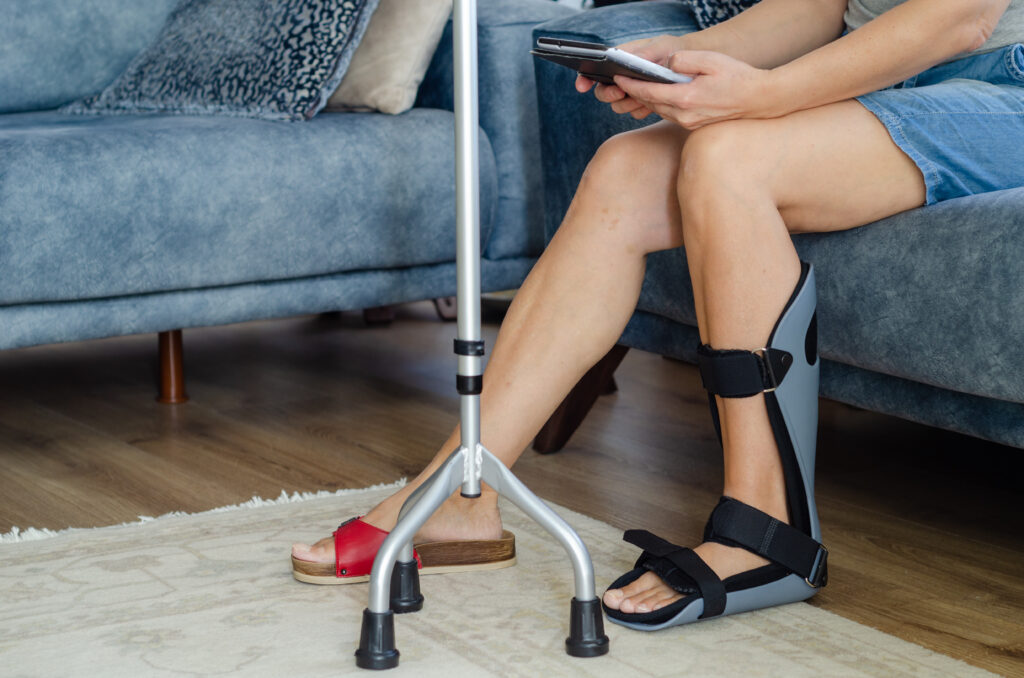Signs & Symptoms of Foot Drop
When you walk, you naturally perform a movement known as dorsiflexion in which you lift the top part of your foot upward to take a step. This movement is a crucial part of walking properly and staying balanced. If you can’t perform this movement properly, you may suffer from a condition known as foot drop or drop foot.
What Is Foot Drop?

Foot drop is a condition in which lifting the front part of your foot is difficult and indicates another underlying medical condition. Your brain, muscles, and nerves play crucial roles in executing the proper dorsiflexion while walking. If one or more of these crucial components isn’t working properly, you may suffer from foot drop.
What Causes Foot Drop?
Foot drop results from weakness or paralysis of muscles in the foot, which often causes the foot not to be able to lift to clear off the ground. This muscle weakness or paralysis can affect any of the muscles in the lower leg. The most common cause of foot drop is an injury to the peroneal nerve. This can happen due to a knee injury or during knee or hip surgery if the surgeon accidentally damages this nerve. This type of injury is more common in older individuals and women. Certain activities can put pressure on your peroneal nerve and contribute to foot drop, such as the following:
- Kneeling for prolonged periods.
- Crossing your legs and remaining sedentary for long periods.
- Wearing a leg cast that sits below your knee.
- Pressure on your knees while sleeping.
- Labor and childbirth.
Certain diseases or disorders affecting the muscles, nerves, brain, or spinal cord may also contribute to foot drop. You’re more likely to suffer from foot drop if you have any of the following:
- Muscular dystrophy.
- Anorexia nervosa.
- Polio.
- Cerebral palsy.
- Parkinson’s disease.
- Charcot-Marie-Tooth disease.
- Multiple sclerosis.
- Diabetes.
- Amyotrophic lateral sclerosis.
- A stroke.
- A brain injury.
Symptoms of Foot Drop
Foot drop causes an unusual gait, known as steppage gait, in which an individual raises their thigh higher than usual to get the drooping foot to clear the ground. The foot may then slap down when it makes contact with the floor. Foot drop may also cause you to walk with shuffling feet or result in frequent trips and falls. Some individuals experience numbness in their toes or the top of their foot.
Foot Drop Diagnosis
Most health care providers can initially diagnose foot drop simply by watching you walk. They may also touch the top of your foot, toes, and ankle to look for numbness. Though your physician can identify foot drop visually, they’ll need to conduct further testing to identify the condition’s underlying cause. This may include one or more of the following tests:
- Ultrasound.
- X-rays.
- MRI.
- CT scan.
- Electromyography.
Treatment for Foot Drop
Foot drop treatment varies greatly by patient. Some people can recover with simple physical therapy exercises performed in the home. Others may need more aggressive interventions. Your doctor may prescribe a foot brace or splint in conjunction with or as an alternative to these treatments.
Physical Therapy
In most cases, physical therapy is the first treatment that your health care provider will recommend. You may learn a series of exercises with a specialist and receive instructions on when and how to perform these activities at home. It’s essential that you keep up with the prescribed physical therapy at home regularly to get meaningful relief from foot drop. These exercises will strengthen your muscles and train your brain to work differently.
- Ankle dorsiflexion: Lay your affected foot across the opposite knee and use the opposite arm to guide your foot through the dorsiflexion movement manually. Alternately, you may wrap a towel or belt around your foot to pull your toes upward into this position.
- Ankle abduction/adduction: With your affected foot lying across the opposite knee, use your hand to move your foot from side to side. If you still have some movement in your foot, remove your hand and twist your foot from side to side using the foot muscles.
- Toe-to-heel rocks: Stand facing a table or chair you can use for support, place your hands on this item, and rock your weight forward onto your toes. Hold for a count of five, then rock backward onto your heels and lift your toes off the ground; hold for a count of five and repeat the entire sequence.
- Toe raises: Place your affected toes on top of your non-affected foot. Use the non-affected foot to guide your toes up and down in the dorsiflexion movement.
- Heel raises: Sit with your feet flat on the ground, lift your heels, and press your first and second toes into the ground while keeping your ankles facing forward. Lower your heels and repeat.
- Marble pickup: Put 20 marbles on the floor in front of you. While sitting, pick up the marbles using the toes of your affected foot and place them into a bowl.
- Ball lift: Place a tennis ball on the floor in front of you and pick it up by holding it between your feet. Lift your legs until they’re extended straight in front of you and hold them here for a count of five before lowering your feet to the ground. Repeat.
Nerve Stimulation
Your physician may refer you to a nerve specialist who can use functional electrical stimulators to apply electrical currents to the peripheral nerves. This can enhance the functionality of the surrounding muscles and improve your movement in the affected foot.
Surgery
If other interventions are unsuccessful, your doctor may recommend surgery to treat your foot drop. Most physicians wait at least three months to see if another treatment option will produce results. Your doctor may also pursue surgery if a nerve laceration is suspected, as this won’t respond to other treatments. Foot drop surgery usually involves moving a tendon from another part of the foot to the front so you can use this alternate tendon to perform dorsiflexion properly.
Schedule Your Foot Drop Consultation in Chicago, IL
Contact our specialists at Gurnee Podiatry & Sports Medicine as soon as possible. Dr. Schoene, Dr. Bever, and Dr. Joseph can help diagnose and treat this condition, providing personalized recommendations for your unique situation.
The woman with a orthotics on her foot is sitting on the sofa at home by Nazile Keskin
